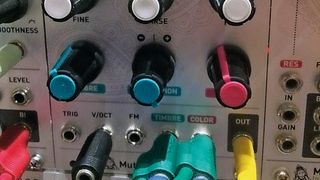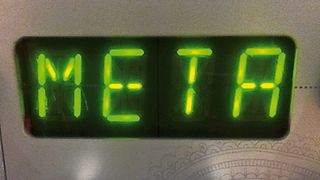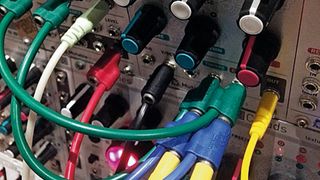How to turn Mutable Instruments Braids into a full standalone voice
Complex tones made simple
Braids was Mutable Instruments' bold entry into the modular world. It's a sonic weapon that packs 40 different synthesis modes, covering a massive range of tones, into a simple panel - which looks like it's just an oscillator.
But that's nicely misleading. Mutable Instruments say: "Most of the timbres it generates are so complex that approaching them with a classic analogue modular set-up would require a full case of oscillators, filters, VCAs, waveshapers and ring-modulators - that's why we call it a macro-oscillator".
In spite of this, the interface really is simple. Twisting an encoder selects the synthesis model as well as navigating a menu to access global parameters. Timbre and Color are our main sound-shaping controls; they're voltage controllable and are doing different things per-algorithm. "Very often, these parameters simultaneously affect several dimensions of timbre, creating very complex movements which would be hard to generate with a traditional set-up." There's also an FM input with attenuator for external frequency modulation and a trigger input for syncing the waveforms and triggering some of the physical models.
Braids covers analogue synthesis, modelling the Yamaha CS-80's impure sawtooth, the continuous waveform morphing found in the RSF Kobol, Micromoog and modern Moogs such as the Sub Phatty and Sub 37, as well as Roland Alpha Juno-style saw wave PWM. There's a wavefolding voice based on the Serge waveshaper, dual oscillator sync patches and full-sounding detunable multi-oscillator ensembles.
Direct digital synthesis styles include ring modulation, band- limited dual pulse trains, swarms of seven sawtooth waves (JP-8000-style supersaws), tuned delay lines, comb filtering, circuit bent toys and emulations of classic waveforms found in the phase distortion based Casio CZ series and Roland D-50. We've even got vocal synthesis modes that range from granular synthesis to a filter matrix that morphs between nasal cavity filters, glottis filters and tongue filters to produce vocal and vowel sounds. It doesn't stop there either, wavetable modes cover plenty of classic wavetables based on such synths as the Waldorf PPG and a comprehensive set of noise modes with filtering, clocked noise, granular clouds and more!
We spoke to the designer, Olivier, about the origins of Braids. "Around the end of 2011 I started collecting little bits of waveform synthesis code for what was going to be a factory- made version of the Ambika Polysynth. My goal was to cover as many different audio generation processes as possible that could provide raw material for synthesis... About 20 or 25 of Braids' synthesis models originate from that time. It became obvious that having all these digital sound sources would be great in a modular system - there was nothing like it in the Eurorack format, probably because the few digital module makers at the time were focused on 'deep' modules."
With so much on offer, Braids may seem daunting to some users, but we can assure you that it's straightforward. We'll go through each of the different synthesis algorithms exploring their sounds, how they can be altered and how they react under modulation.
Get the MusicRadar Newsletter
Want all the hottest music and gear news, reviews, deals, features and more, direct to your inbox? Sign up here.
We'll be using a VCA and envelope for basic amplitude modulation plus a filter to show Braids used in a more typical subtractive style synth patch. Adding an LFO we can get some Timbre and Color modulation (aided by the onboard attenuverter - an inverting attenuator). Impressively, using the onboard VCA and envelope generator, we can turn Braids into a full standalone voice without needing any external modules for sound generation, processing or modulation!

Step 1. We'll first go through each of the synthesis algorithms. Using Bob Borries' excellent illustrated manual, we can easily see what the modes are based on and what the Timbre and Color parameters do in each mode.

Step 2. Let's use a VCA and envelope for basic amplitude modulation of Braids' main output. Adding an LFO we can explore how the Timbre and Color react under voltage control. We'll make use of Braids' onboard attenuverter (an inverting attenuator) for the Timbre control.

Step 3. Using the encoder we enter the menu system and enable META mode. This uses the FM input to allow voltage control over mode selection itself! We add sample and hold CV to randomly change between plucks, saw waves, vocal modes, wavetables and physical models.

Step 4. With its onboard envelope and VCA we can turn Braids into a self-contained synth voice. Using the trigger input we can fire the internal envelope, when set to affect the signal's amplitude. We can also affect FM, Timbre or Color individually or together.
Future Music is the number one magazine for today's producers. Packed with technique and technology we'll help you make great new music. All-access artist interviews, in-depth gear reviews, essential production tutorials and much more. Every marvellous monthly edition features reliable reviews of the latest and greatest hardware and software technology and techniques, unparalleled advice, in-depth interviews, sensational free samples and so much more to improve the experience and outcome of your music-making.

"If I wasn't recording albums every month, multiple albums, and I wasn't playing on everyone's songs, I wouldn't need any of this”: Travis Barker reveals his production tricks and gear in a new studio tour

“My management and agent have always tried to cover my back on the road”: Neil Young just axed premium gig tickets following advice from The Cure’s Robert Smith











